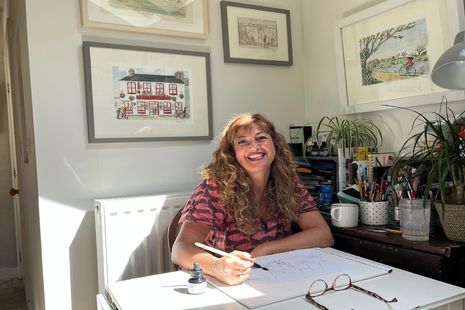Illustrator Roxana de Rond on finding beauty in everyday Cambridge
Johana Trejtnar speaks to Cambridge illustrator Roxana de Rond about pubs, snowball fights, and using Cambridge’s minutiae to make art

Roxana de Rond, a Cambridge illustrator, lives in a little row house overgrown with flowers. The walls of her living room are lined with her own paintings. They show happy figures frolicking on Jesus Green, skipping through Cambridge’s Botanical Gardens and gathering for a pint at The Eagle. Her style is light and airy, cheerful and full of colours. The figures in her paintings are the normal inhabitants of Cambridge – both town and gown – riding their bikes, throwing snowballs, or all tangled up in their dogs’ leashes.
I first met Ms. de Rond at the Botanical Gardens’ Apple Day, where she was manning a market stall – as she often does at local fairs – selling colourful images that capture Cambridge as a joyous place, overflowing with activity and smiles. Immediately her style, reminiscent of Quentin Blake’s expressive illustrations, struck me as the perfect complement to Cambridge’s vibrant, pulsing atmosphere, where nothing ever stands still. Wanting to see Cambridge through the artist’s perspective, I visited de Rond in her home, which looks as if it grew out of one of her illustrations.
De Rond has lived in Cambridge for the past 22 years, painting the town as it has changed and grown. While Cambridge is known for the University’s many students who pass through, only staying for a couple of years before moving on, Cambridge is also a beloved home to many – including de Rond. For her, the town has always been a great inspiration with its changing seasons and constant buzz.
“Immediately her style, reminiscent of Quentin Blake’s expressive illustrations, struck me as the perfect complement to Cambridge’s vibrant, pulsing atmosphere, where nothing ever stands still”
Originally, de Rond did not plan on becoming an illustrator. She studied English literature at university. “But then,” she recounts, “when I was a very poor student, I wanted to get my friends presents. I didn’t really have money, so I started drawing them cards or pictures.” Eventually, she discovered that it was easier for her to tell stories through pictures than through words.
After graduating, de Rond moved towards art, getting an MA in Children’s Book Illustration. It wasn’t until she went on maternity leave with her daughters that she started to find her characteristic style. “I didn’t really have that much time to draw, so what I did is I had a drawing diary, which I kept every day.” Even if she only spent three minutes with her diary, de Rond would always jot down something she remembered from the day.
Eventually she noticed that the things she remembered were always the nice, quotidian things – “the things people would sort of overlook, those times when people are maybe the happiest, but in a quiet way”. When she started drawing more, de Rond continued drawing cheerful, happy scenes, full of popping colours. Art, she says, “wasn’t what I set out to do, but it’s absolutely the thing that I love”.
One of her favourite recent projects, de Rond recalls, was a series of pub storefronts that she drew during the Covid-19 pandemic. “I love a good pub,” she recounts, “it’s a place where everybody’s equal and it’s all friendly.” Pubs, for de Rond, are both a fundamental part of Cambridge and of her illustrations themselves. They offer a sense of warmth and commonality – a place where everyone is on the same level, both town and gown, enjoying the moment.
“Eventually she noticed that the things she remembered were always the nice, quotidian things – ‘the things people would sort of overlook, those times when people are maybe the happiest, but in a quiet way’”
During Covid, when all of Cambridge’s pubs were closed, she decided to create a sort of elegy to them, drawing their storefronts all over the city. “I never drew a single mask. I never drew the emptiness of lockdown,” she says. Instead, she drew the outsides of the pubs, with laughing, chatting, happy people on the sidewalks. It was her way of preserving the spirit of those places and what they meant to the people of Cambridge.
With its constant movement, deep-seated history and many pubs, Cambridge is an inspiration for de Rond. Even after 22 years, she says, “I still am always finding things that are changing, or just a little bit different and beautiful again and or there’s new things always popping up.” The town’s past and present interact in de Rond’s paintings, with Trinity College’s majestic entryway towering behind somebody lugging along a Christmas tree. That contrast, she says, makes the town come alive.
In Cambridge, she says, “there’s a kind of constant movement, especially from [the students’] side.” But from the local side, she says, there is not so much. There are a lot of people who’ve been here a long time, whose lives are invested here. “And so I think the combination works really well: because it’s energy, it creates energy.” Most importantly, she says, she loves Cambridge and “drawing out of love,” de Rond recounts, “makes it just that much more pleasurable.”
Right now, de Rond is working on a series of little illustrations of Cambridge colleges. Instead of capturing their most famous postcard-images, she draws their human side – a snowball fight in front of King’s College Chapel, wisteria on the Sidney Sussex fence, or a dog passing the Magdalene waterfront on a punt.
De Rond told me that once someone described the essence of her work with the word “contentment”. Sometimes, the busy times of Cambridge exams make it difficult to remember that such things exist in Cambridge. Perhaps we should pay closer attention to De Rond’s belief that Cambridge is “just getting better and better”.
 News / SU reluctantly registers controversial women’s soc18 December 2025
News / SU reluctantly registers controversial women’s soc18 December 2025 News / CUP announces funding scheme for under-represented academics19 December 2025
News / CUP announces funding scheme for under-represented academics19 December 2025 Features / Should I stay or should I go? Cambridge students and alumni reflect on how their memories stay with them15 December 2025
Features / Should I stay or should I go? Cambridge students and alumni reflect on how their memories stay with them15 December 2025 Fashion / The art of the formal outfit 18 December 2025
Fashion / The art of the formal outfit 18 December 2025 News / Dons warn PM about Vet School closure16 December 2025
News / Dons warn PM about Vet School closure16 December 2025









